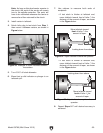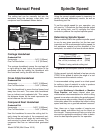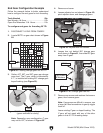
Model G0765 (Mfd. Since 12/13)
-39-
The cutting tool can be manually fed into the
workpiece using the carriage, cross slide, and
compound rest handwheels shown below.
Carriage Handwheel
Graduated Dial
Increments ................................... 0.01" (0.25mm)
One Full Revolution .......................0.8" (20.3mm)
The carriage handwheel moves the carriage left
or right along the bed. Adjust the position of the
graduated scale by holding the handwheel with
one hand and turning the dial with the other.
Cross Slide Handwheel
Graduated Dial
Increments ............................... 0.001" (0.025mm)
One Full Revolution ..................... 0.04" (1.02mm)
Use this handwheel to move the tool toward and
away from the work. The cross slide handwheel
has an indirect-read graduated dial. This means
the distance shown on the scale represents the
actual distance the tool moves.
Compound Rest Handwheel
Graduated Dial
Increments .............................. 0.001" (0.025mm)
One Full Revolution ..................... 0.04" (1.02mm)
Use this handwheel to move the cutting tool lin-
early along the set angle of the compound rest.
Set the compound rest angle by hand-rotating it
and securing in place with two cap screws. The
compound rest has an indirect-read graduated
dial.
Figure 45. Manual feeding controls.
Carriage
Handwheel
Manual Feed
Compound
Rest
Handwheel
Cross Slide
Handwheel
Spindle Speed
Using the correct spindle speed is important for
getting safe and satisfactory results, as well as
maximizing tool life.
To set the spindle speed for your operation, you
will need to: 1) Determine the best spindle speed
for the cutting task, and 2) configure the lathe
controls to produce the required spindle speed.
Determining Spindle Speed
Many variables affect the optimum spindle speed
to use for any given operation, but the two most
important are the recommended cutting speed for
the workpiece material and the diameter of the
workpiece, as noted in the formula shown below.
Cutting speed, typically defined in feet per minute
(FPM), is the speed at which the edge of a tool
moves across the material surface.
A recommended cutting speed is an ideal speed
for cutting a type of material in order to produce
the desired finish and optimize tool life.
The books Machinery’s Handbook or Machine
Shop Practice, and some internet sites, pro-
vide excellent recommendations for which cutting
speeds to use when calculating the spindle speed.
These sources also provide a wealth of additional
information about the variables that affect cutting
speed and they are a good educational resource.
Also, there are a large number of easy-to-use
spindle speed calculators that can be found on
the internet. These sources will help you take into
account the applicable variables in order to deter-
mine the best spindle speed for the operation.
Cutting Speed (FPM) x 12
*Recommended
Dia. of Cut (in inches) x 3.14
Spindle
Speed
(RPM)
*Double if using carbide cutting tool
=
Figure 46. Spindle speed formula for lathes.


















